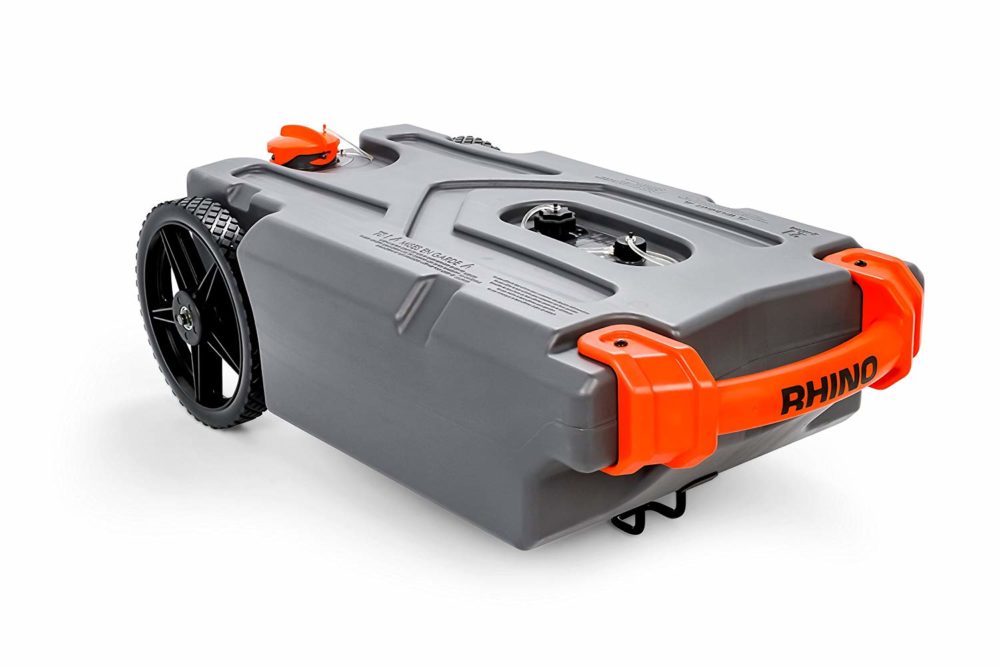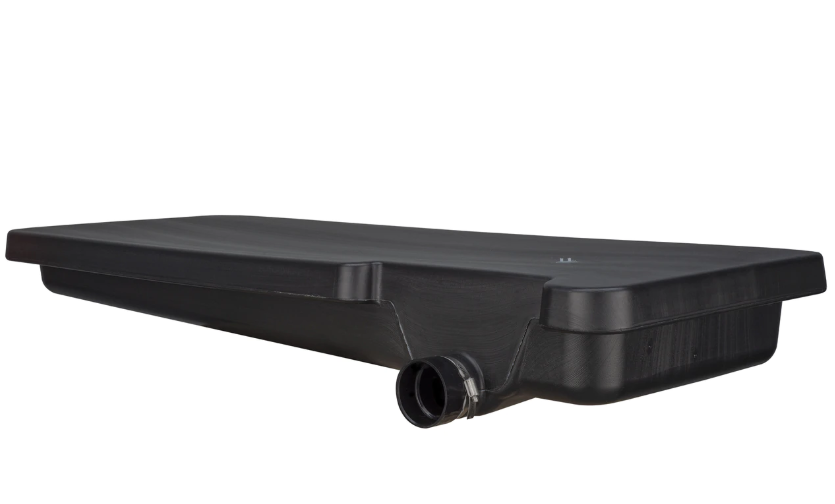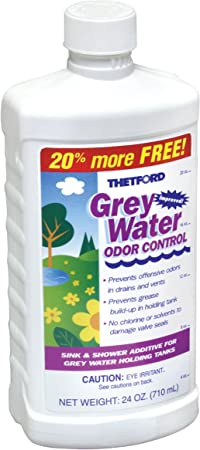One of my least favorite aspects of RV camping is tending to the wastewater holding tanks.
The grey water tank always seemed like it was just a simple matter of hooking up the sewer hose and opening the grey water valve. But over the years of experience, and in talking to other campers, I have learned the grey water tank also requires maintenance.

Contents
- 1 Understanding a Grey Water Tank
- 2 What Does the Grey Water Tank Do?
- 3 How Big is an RV Grey Water Tank?
- 4 Types of RV Grey Water Tanks
- 5 Grey Water Tank Vs Black Water Tank
- 6 What Happens When the Grey Water Tank is Full?
- 7 Grey Tank Maintenance
- 8 Best RV Grey Water Tank Treatment
- 9 How do I Dispose of RV Grey Water?
- 10 How Much Does a Grey Water Tank for an RV Cost?
- 11 FAQs
Understanding a Grey Water Tank
The grey water tank is a separate tank that collects water from sinks, showers, and tubs, and washing machines installed in your RV—any water that does NOT go through a toilet. Grey water is relatively “clean” water, and typically includes soap, dirt, hair, and kitchen food particles.
The grey water tank is a separate holding tank, like the black-water tank, but does not collect the more toxic, infectious materials of human waste. Still, some solid materials find their way into the grey water tank, and this tank should be flushed periodically to minimize odors or clogging of the grey water drain.
While “grey water” is not as toxic as the contents of the blackwater tank, grey water still contains contaminates—kitchen residue, soaps and cleansers, and other types of waste that still pose potential environmental hazards.
With the exception of some Bureau of Land Management areas, simply dumping holding tanks in your yard, down a street drain, or even a remote corner of some wilderness area, is not permitted.
Both black and grey wastewater tend to attract flies and potentially spread diseases while the chemicals from cleaning products and soaps can introduce toxic materials into groundwater and streams.
What Does the Grey Water Tank Do?
The grey water tank simply collects and holds water from sinks, tubs, and showers until you have an opportunity to properly empty the tank’s contents.
Grey water can develop an offensive odor over time. If you are unable to empty the tank, and odor becomes a problem, there are “grey water odor control” treatments available at camp stores.
How Big is an RV Grey Water Tank?
The answer is simply “it depends.” Typically, the grey water holding tank is the largest of the three holding tanks. It is larger than the freshwater holding tank. This means that your freshwater will run out before the grey water tank is full.
Blackwater holding tanks are smaller than grey water tanks since they are limited to collection of toilet waste matter.
Types of RV Grey Water Tanks
There are two basic types of grey water tanks—permanently installed tanks on the RV and portable wastewater tanks. On most campers and RVs, properly sized tanks are mounted under the floor of the camper, with connections as needed for wastewater to flow into the tanks. The tanks have drains on the street-side of the camper, with connections to empty the tanks into an in-ground sewer connection.
If you do not want to move the camper to empty the holding tanks, a portable waste holding tank can be used to collect wastewater from the RV and transfer it to the dump station.
Grey Water Tank Vs Black Water Tank
Because black-water tanks are limited to collecting waste from toilets, they are typically smaller tanks, and are treated differently. These holding tanks may be treated with toilet compounds that help break down waste as well as controlling odors.
Grey water tanks have more than twice the volume of black water tanks. Occasionally, grey-water tanks may develop and unpleasant odor. While there are products to treat grey-water odor issues, often adding some liquid dish detergent to the grey water tank will reduce or eliminate the odor.
Note, never pour cooking oil or grease into a camper’s wastewater system. As it cools, it can block the flow of liquids out of the tank and require costly maintenance.
What Happens When the Grey Water Tank is Full?
Most modern campers have indicating systems that show the level of fluids in both grey and black water holding tanks. Without these indicators, the only indication a grey-water tank is full is that water will back up, usually up through a shower drain or a sink. When this happens, the only solution is to empty the holding tanks, either into an approved dump station or into a portable holding tank.

Grey Tank Maintenance
Cleaning an RV Grey Water Tank
Provided that no grease or oil is in the grey-water tank, to clean the tank:
- Drain and flush the contents of the tank. Then close the tank drain valve.
- If unpleasant odors linger, there are grey water tank treatment chemicals to help eliminate those odors or treat the tank with a mixture of water and dish detergent or vinegar.
- Put several gallons of warm water in the holding tank, mixed with about half a cup of dish detergent or vinegar. Let it stand overnight or longer. Drive the camper around so that the water will splash around in the tank, then flush the tank with fresh water.
- You should regularly drain and rinse your RV’s grey water tank. However, first drain the black tank so all that relatively clean, soapy water can flush the sewer hose of the truly unpleasant stuff.
- Ideally, when camping, keep the dump valves closed and open them only when they need to be dumped. This provides more force from the water to better flush the system.
- For a badly clogged system you may have to boil 2 to 4 pots of water and pour this down the drain to open clogged water lines. Repeat as needed.
Best RV Grey Water Tank Treatment

There are several very effective grey water odor control treatments available at very reasonable prices.
Thetford, a name recognized for all things associated with camper waste water systems markets their “Grey Water Odor Control,” available from most RV supply shops and online from Amazon. The 24 oz. container lists for $11.93.
A similar, TST Lemon Scent RV Grey Water (liquid) Odor Control is distributed by Camco in a 64 oz. container, also available from Amazon at a list price of $11.99.
How do I Dispose of RV Grey Water?
Assuming you know how to attach your sewer hose to the RV and to a sewer connection, draining the grey water tank is simple. It is a good idea to have a set of rubber gloves available for this process.
Note, however, if you are going to drain both holding tanks, drain the blackwater thank first, then the grey water tank. It is also a good idea to disconnect the sewer hose from the RV (but not the sewer connection), and flush it with some fresh water before stowing the hose.
If you frequently camp long periods of time in remote areas, a portable waste-holding tank is recommended.
How Much Does a Grey Water Tank for an RV Cost?
At a minimum, a new tank will cost between $100 and $300 or more, depending on the size, plus any installation labor charges. Labor can cost as little as $65 per hour to as much as $150 or more.
Proper maintenance and periodic (annual) cleaning will prevent the need for more costly repairs or replacement.
FAQs
Can I Dump Grey Water on My Property?
Every state has a law or regulation that prohibits the dumping of grey or black water on the ground or into any stream, pond, lake, or river anywhere, including your own land. Holding tanks should only be emptied into a sewer system, an approved septic tank system, or at a designated dump station.
Is it OK to Leave the Grey Water Tank Valve Open When Camping?
We recommend leaving the wastewater valves closed until you need to dump the tanks. Then, with the sewer hose connected, first open the blackwater tank valve and allow it to drain. You may want to flush some freshwater through the toilet to help clean out the contents of the black water tank.
Then open the grey water valve. The flow of grey water will help flush the sewer hose removing any remaining black water “matter.”
Finally, when disconnecting the sewer hose when breaking camp, we suggest running fresh water through the hose before stowing the hose in your camper.
How Often Should You Empty an RV Grey Water Tank?
Holding tanks tend to drain more completely—that is carry most of the suspended matter in the tanks—if the tanks are at least half full. This produces stronger water flow to remove the tank’s contents.




